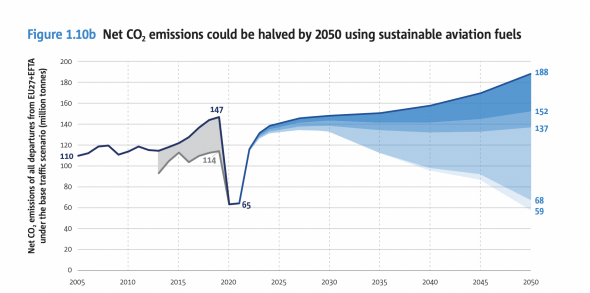NEWSLETTER
In Conversation: Holly Boyd-Boland, Virgin Atlantic


In August, we published a story showing that while most industry sectors in the EU decreased their carbon output, emissions from the transport sector increased, with air travel accounting for a large share of that.
Now EASA has published its annual European Aviation Environmental Report (download it here).
This says that with current technology, emissions will continue to increase (see above diagram), likely exceeding 2019 levels by the middle to the end of this decade.
However, there is a road map that can see a significant reduction in CO2 emissions, of up to 69%.
This includes a combination of better aircraft technology and design, air traffic management, Sustainable Aviation Fuel (SAF), and next-generation aircraft.
Note that in EASA’s best-case scenario, the biggest share of emissions cuts comes from the use of SAF, with only a relatively modest amount attributable to next-generation aircraft.
This mirrors the ICCT’s projections, which show much the same – that SAF will need to do much of the net zero heavy lifting.
The reason of course is that aircraft in production today will quite possibly still be flying in 2050, if not as passenger then as cargo aircraft.
In fact, EASA mentions that the average aircraft age per flight has increased to 11.6 years. For existing aircraft still flying over the next few decades, the only realistic solution is drop-in fuels.
According to EASA, the current SAF supply remains low at less than 0.05% of total EU aviation fuel use, so there’s a long way to go.
This is especially as the European Commission has proposed a SAF blending mandate for fuel supplied to EU airports, with minimum shares of SAF increasing from 2% in 2025 to 63% in 2050.
One hopeful sign is the development of E-Fuels that don’t rely on land use or agricultural resources, and in the next section, we’ll talk about one innovative company in that space.
(Image from EASA, the chart shows different scenarios depending on the same technology as today being used, air traffic management, SAF and zero emissions aircraft.)
Last week, one of the companies featured in our recent carbon removals power list, Air Company, announced that it would be making E-Fuel from CO2, which it is calling “AIRMADE”.
Air Company was previously best known for making vodka (and perfume) out of air. Now it is pivoting to fuels, with partners on board that include JetBlue, and supersonic aircraft company Boom.
In fact, in last week’s Sustainability in the Air podcast, Boom CEO Blake Scholl signaled that the company was looking to be a “Switzerland of SAF” in diversifying its suppliers.
Having previously signed an agreement with Prometheus (which is also turning CO2 to fuel), the Air Company announcement would seem to be the first sign of that.
Meanwhile, JetBlue signaled its intention to purchase 25 million gallons of AIRMADE.
Currently, available SAF offers approximately 80% reduction in emissions per net gallon on a lifecycle basis.
Air Company says that it takes this a step forward, offering an additional 14% reduction, or a total 94% GHG reduction.
Importantly by using CO2, it negates feedstock constraints. Air Company believes that this advancement offers an additional path to achieving commercial viability for SAF at scale, which will be key to the aviation industry’s net-zero goals.
(Image via Air Company)
Deal news
Swiss teams up with Breitling to promote sustainable fuels (Business Traveller)
Delta’s accelerated Sustainability Flight Plan (Delta Newsroom)
With premium economy soft product Delta poses sustainability questions (Runway Girl Network)
The airline race for a breakthrough fuel to cut one billion tons of carbon is just starting (CNBC)
How airlines’ environmental investments are already paying dividends (Flight Global)
Taxation won’t solve sustainability issues, says IATA director (Travel Tomorrow)
© 2022 SimpliFlying Pte. Ltd.